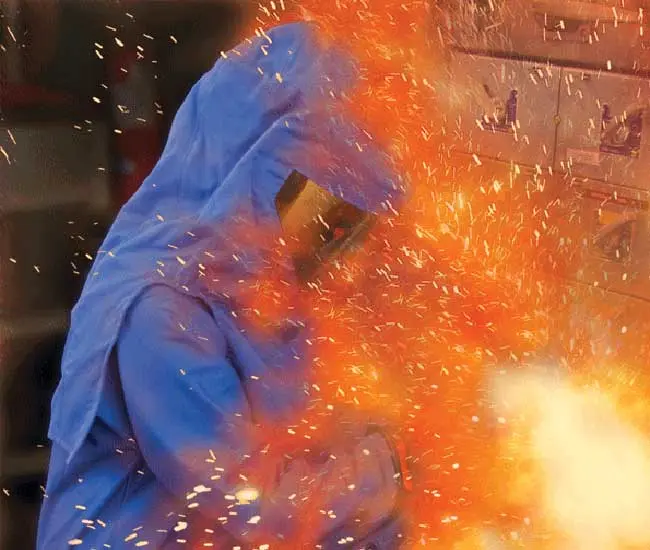Arc Flash Meaning Explained

Arc Flash Meaning - Simply put, it is a sudden release of energy due to an arcing fault between electrical conductors or between a conductor and a ground. This arc flash event occurs when an electrical arc forms, creating a high-temperature plasma that can cause severe damage and injury. An arc flash (AF) typically happens when energized electrical equipment experiences a short circuit, often triggered by equipment failure, human error, or conductive dust. The intense heat and light produced during an AF can be catastrophic, making understanding and preventing these events crucial for electrical safety.
What Are the Physical Characteristics?
The physical characteristics of an AF are both dramatic and dangerous. When arc flash occurs, the temperature can reach levels comparable to the surface of the sun, melting and vaporizing metal parts. Key characteristics include:
- Heat and Light: AF emits intense heat and brilliant light, capable of causing severe burns (degree burns) and temporary or permanent blindness.
- Arc Blast: Alongside the flash, an arc blast occurs, generating a pressure wave that can damage equipment, rupture eardrums, and throw workers across a room.
- Molten Metal: The intense heat liquefies metal parts, producing molten metal that can cause additional injuries and ignite fires.
- Incident Energy: This is the energy released during an AF, measured in calories per square centimeter (cal/cm²), which directly impacts the severity of burns and the damage radius.
Why is Understanding the Arc Flash Meaning Important for Electrical Safety?
Understanding AF is critical for maintaining a safe working environment in any setting that involves electrical systems. The risks of arc flash include severe injuries, such as degree burns, electric shocks, and potential fatalities. Awareness and proper precautions can significantly reduce these risks. Key reasons for understanding AF include:
- Worker Safety: Proper knowledge and training help protect workers from the severe consequences of AF incidents.
- Regulatory Compliance: Compliance with safety standards, such as those outlined by OSHA and NFPA 70E, is essential to avoid legal penalties and ensure a safe workplace.
- Preventive Measures: Understanding common causes of arc flash, such as faulty circuit breakers, short circuits, and arcing faults, enables the implementation of effective preventive measures.
What Distinguishes It from Other Electrical Hazards?
An AF is distinct from other electrical hazards due to its unique characteristics and the extreme energy release involved. Unlike electric shocks, which typically occur due to direct contact with live electrical parts, an AF results from an arcing fault that creates an explosive release of energy. Key distinctions include:
- Energy Release: The incident energy in an AF is much higher than in typical electric shock scenarios, leading to more severe injuries and damage.
- Heat and Light: The intense heat and light produced are specific to AF events, causing burns and blindness that are not common in other electrical hazards.
- Pressure Wave: The arc blast that accompanies an AF is a unique phenomenon, capable of causing structural damage and additional injuries beyond electrical burns.
How Do the Concepts of Incident Energy and AF Boundaries Relate?
Incident energy and AF boundaries are critical concepts in managing the risks associated with AF events.
-
Incident Energy: This refers to the amount of thermal energy (measured in cal/cm²) that a worker might be exposed to during an AF. Higher incident energy levels increase the severity of potential injuries and dictate the type of personal protective equipment (PPE) required. Protective clothing and other PPE must be rated to withstand the calculated incident energy to protect workers effectively.
-
AF Boundaries: These are safety zones established around potential hazards to protect workers. There are typically three boundaries:
- Flash Protection Boundary: The distance at which the incident energy equals 1.2 cal/cm², the threshold for curable burns.
- Limited Approach Boundary: The distance within which only qualified workers, with appropriate training and PPE, may enter.
- Restricted Approach Boundary: A closer boundary that requires a documented work plan and special equipment to enter.
AF events present significant risks in any environment involving electrical systems. By understanding the meaning of AF, recognizing its physical characteristics, and implementing appropriate safety measures, organizations can protect their workers and ensure compliance with safety standards. Key concepts such as incident energy and AF boundaries play a vital role in defining safety protocols and selecting the right protective devices. With proper education, preventive maintenance, and adherence to safety guidelines, the risks of arc flash can be effectively managed and minimized.
On-Site Training
Interested in cost effective, professional on-site electrical training?
We can present an Electrical Training Course to your electrical engineering and maintenance staff, on your premises, tailored to your specific equipment and requirements. Click on the link below to request a Free quotation.
EF PARTNER MEDIA
Product Showcases
Shared Media
















